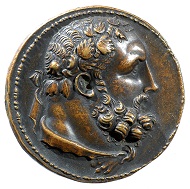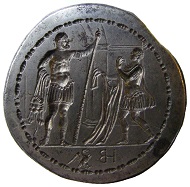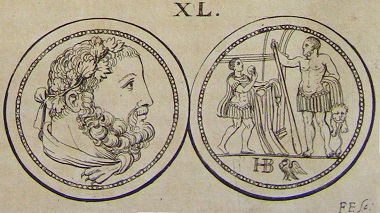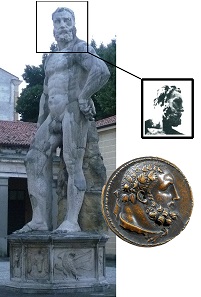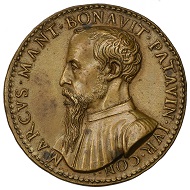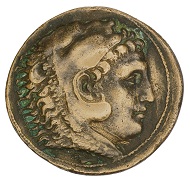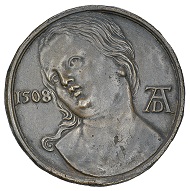by Michael Matzke
translated by Annika Backe
A Hercules medal with a particularly high relief is considered to be one of the so-called “Paduans” because the dies for this medal are kept in Paris together with those that were used for the “Paduans” proper, that is the sestertius copies by Giovanni da Cavino (1500-1570). Both style and signature, however, speak against an authorship of Cavino. Nevertheless, in Padua, everything falls into place for solving the mystery of this impressive struck medal.
Medal on Hercules featuring Deianeira handing over the poisoned robe to the hero, specimen from the collection of Ludovic Demoulin de Rochefort (1515-1582) integrated in the Amerbach Cabinet, Basel Historical Museum (HMB) inv. 1905.744.
In the second half of the 17th century, a large series of dies made in the workshop of the Padua-based gold smith and medallist Giovanni da Cavino (1500-1570) was sold by his descendants to Paris, where they are still kept in the Cabinet des Médailles of the Bibliothèque nationale de France. As early as 1692, Claude du Molinet published the dies made by this – already at that time highly appreciated – medallist that were then kept in the Cabinet de la Bibliothèque de Ste. Geneviève.
Dies for the medal on Hercules from the workshop of Giovanni da Cavino (1500-1570), Bibliothèque nationale de France, Cabinet de Médailles, SC. PAD. 24 & 45.
Under no. XL, the medallion of Hercules is recorded and described. Although the author had no difficulties in describing the specimen, both the head with the wreath made of oak leaves and the handing over of the robe that was poisoned by the minotaur Nessos, he could not explain the signature on the reverse, a ligatured HB.
Reversed reproduction of the Hercules medal dies in Claude du Molinet’s publication, University Library of Basel, sign. AD I 85:1-2.
While Claude du Molinet, referring to an anonymous friend, suggested to read HB as “Hercules Bassiani” – Alessandro Bassiano was an antiquarian scholar who, together with Cavino, designed the medals in the antique manner –, another interpretation has been put forth by Giovanni Gorini, who favoured “Hercules Benavidis” instead: the head of Hercules on the medal closely corresponds to the more than 7 meters high monumental statue that Marco Mantova Benavides (1489-1582), prominent lawyer and one of the leading art patrons in the Venetian university town, had erected in the backyard of his new palazzo in about 1544/45.
Hercules medal compared to the Hercules statue in the backyard of the palazzo of Marco Mantova Benavides (1489-1582), not far from the Church of the Eremitani where he also had his monumental wall tomb erected.
Benavides considered the proverbial labours of the ancient hero and his virtues as a model for his own efforts. The inscription in a graphic representation by Enea Vico (1523-1567), which gives an idealized depiction of this Paduan Hercules statue in an ancient landscape, stressed that Benavides had this monument erected because Hercules had liberated the world of all misery („tristitiam orbis depulit omnem“). The medal’s obverse accordingly features Hercules as triumphator with the wreath made of oak leaves, the lion’s skin and on the reverse with a scepter-like oversize club, whereas the depiction on the reverse, in the sense of a vanitas motif, alludes to the death of the hero. The direct model for this reverse depiction – albeit without the triumphal arch – derives from a copper engraving by Hans Sebald Beham (1500-1550), to which the abbreviation might also refer. This is a common feature on Renaissance medals that triumph and death are directly facing each other.
Medal by Giovanni da Cavino on Marco Mantova Benavides (1489-1582), on the reverse bearing a temple aedicula and an inscription summoning the “Eternity [of the family?] of Mantua” (“Aeternitas Mant.”), HMB inv. 1905.582.
Through the Amerbach Cabinet further medals and plaquettes on Hercules have come down to us that might also be linked with the circle of Benavides, but they were made by other artists. It is possible, therefore, that Benavides commissioned this medallion on the hero he held in such high esteem, just as he had Giovanni da Cavino creating several medals with his own portrait.
Plaquette on Hercules with lion’s skin, HMB inv. 1905.5082.
Medal on Alexander the Great as Hercules copying a Macedonian tetradrachm, yet exhibiting further motifs of Hercules on the reverse, including the club and the apples of the Hesperides, HBM inv. 2009.180.1.
As an abbreviation of “Hercules Benavidis”, the signature would thus refer to the Paduan Hercules statue, while the style of the reverse portrait, being unusual for Cavino, could be explained by the dependence on the monumental statue. However, on coins and in the inscription of the graphic representation by Enea Vico, for example, Benavides was called “Mantua” (“peramplo hoc signo Mantuae cura reflorescit”), treating Benavides as a byname. Besides, the ciphering in two ligatured initials is somehow counterproductive for any clear message; additionally, the possessive designation of the ideal hero as “Hercules of Benavides” would also somehow contradict Benavides’ veneration of him. But the Hercules statue gives yet another clue as to how the signature on the medal can be understood. On behalf of Benavides, the young artist Bartolomeo Ammanati (1511-1592) from Tuscany created this first monumental Hercules statue of Modern times and some other works before he went to Florence and became one of the most distinguished sculptors and architects. In Latin, his name reads “Bartolomeus Hammanatus”, thus his initials would be a B and an H. So it might be assumed that at least the draft for this medal was made by Bartolomeo Ammanati while the dies were cut by Giovanni da Cavino as the technically most experienced master of the struck medal. After all, in terms of technics, the dies for these medals do not differ from those of the Paduan medals after the Roman sestertii. In much the same way, there is a plaquette featuring the head of Lucretia, the monogram of Dürer and the date 1508, since it was created on the basis of a drawing of the suicide of Lucretia by Dürer. In this case, too, the creator is not the same person as the medalist whose identity, by the way, cannot be ascertained anymore.
Plaquette with the head of Lucretia, after a drawing of Albrecht Dürer (1471-1528), after 1508, HMB inv. 1905.591.
Therefore, in addition to his monumental marble statue, Marco Mantua Benavides had also a medal created by the same artist Bartolomeo Ammanati, whereas the dies were engraved and the intricate striking of the medallions was executed by Giovanni da Cavino, outstanding master of the struck medal. In this sense the statue of Hercules in the backyard of the palazzo of Benavides turns out to be a pivotal object for the interpretation of this impressive medal. This is also one of the reasons why this Hercules medallion became a lead item of the exhibition “Faked Antiquity? The Paduans and the Fascination with Antiquity” which can be visited in the Basel Historical Museum through May 8.
Please find the website of the Basel Historical Museum here.
You may have a look at several very special objects at the Basel Coin Cabinet online.
If you prefer more details and more numismatics, please read this article written by Michael Matzke on the history of the Coin Cabinet.
And Part 1 of the “Numismatic expeditions” is available here.



